There’s something about woollen felt that appeals to the senses. Is it the warmth, the colours, the texture, or something else?
Felting has a long history of practical and decorative applications. Offering a textural and tactile appearance that can stimulate the desire to touch, it can be meditative to create, satisfying to embellish and an exciting and versatile material with which to sculpt.
Using a combination of friction, soap and water to felt together wool fibres, a new fabric is formed that can be moulded into whatever you desire.
From wall hangings to novel multi-eyed sculptures, we found artists from around the world – Latvia, Ukraine, Canada, Scotland and England – and discovered the unique ways in which they create alchemy from wool.
Their two and three-dimensional artworks encompass all the attractions of textile art – colour, texture and embellishment.
From drifts of felted fibre Jackie Cardy creates flowers and leaves with machine and hand stitch. Moy Mackay’s affection for the crofts and bothies of Scotland are similarly brought to life with carefully stitched lines.
We learn about Dagmar Binder’s passion for sculpture and Diana Nagorna’s skill in creating sequined and beaded garments. Ksenia Shinkovskaya’s life changing experiences gave birth to a whole new range of boggle-eyed creatures and Fiona Duthie’s swathes of hot colour made her viewers examine their own carbon footprint.
Whether you want to make or simply admire felt, whether your interest is in the process or the story behind their works, these artists offer something for every textile art devotee.
Jackie Cardy
Jackie Cardy likes to work with her hands, her head and her heart – and that’s what makes her a true artist.
It’s easy to be captivated when gazing at Jackie’s work. She has an innate ability to unite colours in blended wool and then, through stitch, form images, often inspired by flowers and leaves.
Her mark-making on felt brings the softness and textures of the wool alive and there is a striking contrast as they meet bursts of colour, appliquéed with silk velvet, creating interest and drawing the eye.
Ancient traditions and marks in the landscape ‘swish about’ in Jackie’s head with some ‘falling out’ onto the fabric. She values the fact that felt can be cut to shape without fraying, which helps when making her smaller pieces like brooches.
“I use my sewing machine needle like a pen and have stitched many hundreds of miles over silk, wool, and velvet.
I have no elves, each piece is stitched by me.”
Jacky Cardy, Textile artist
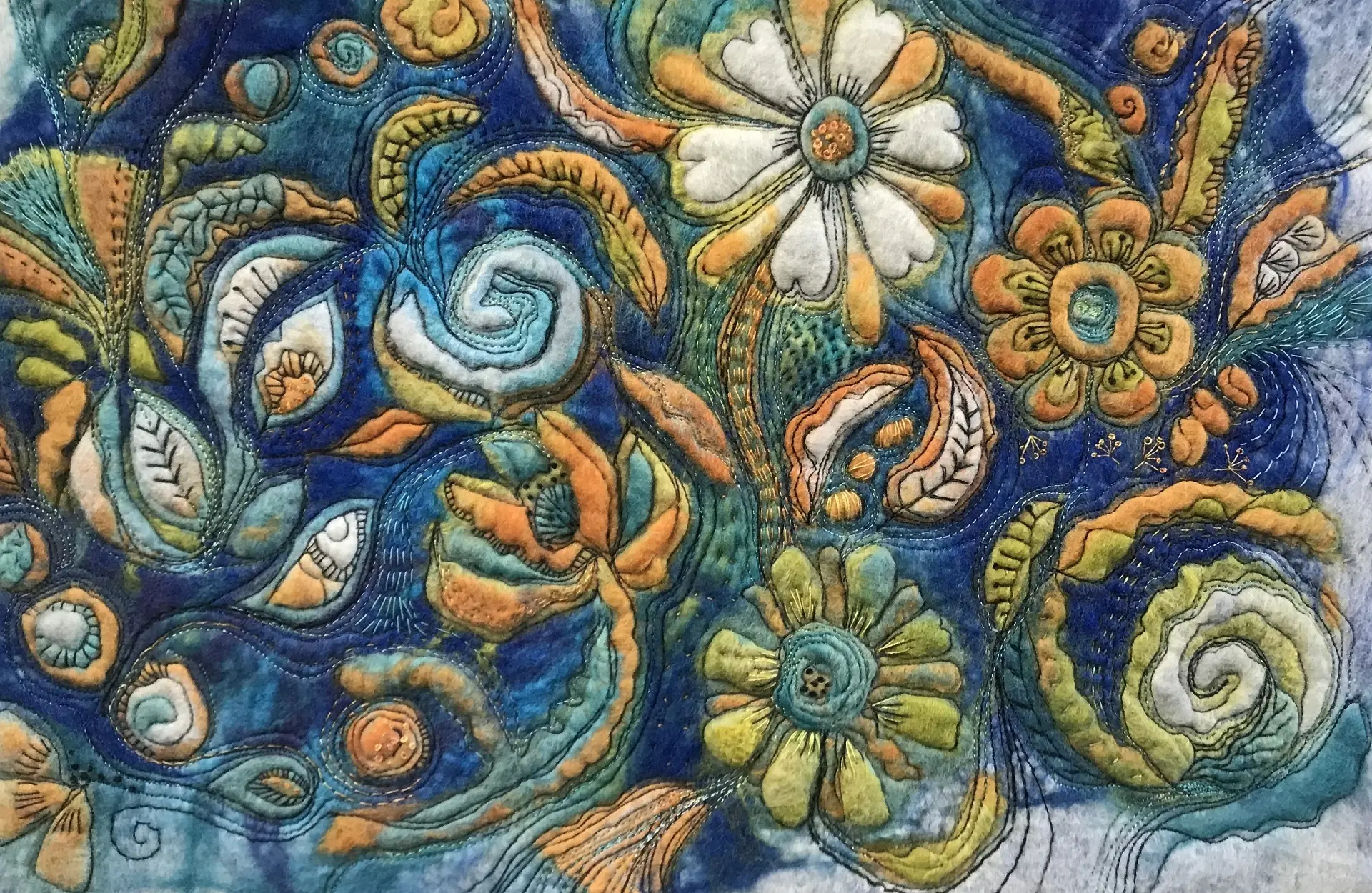
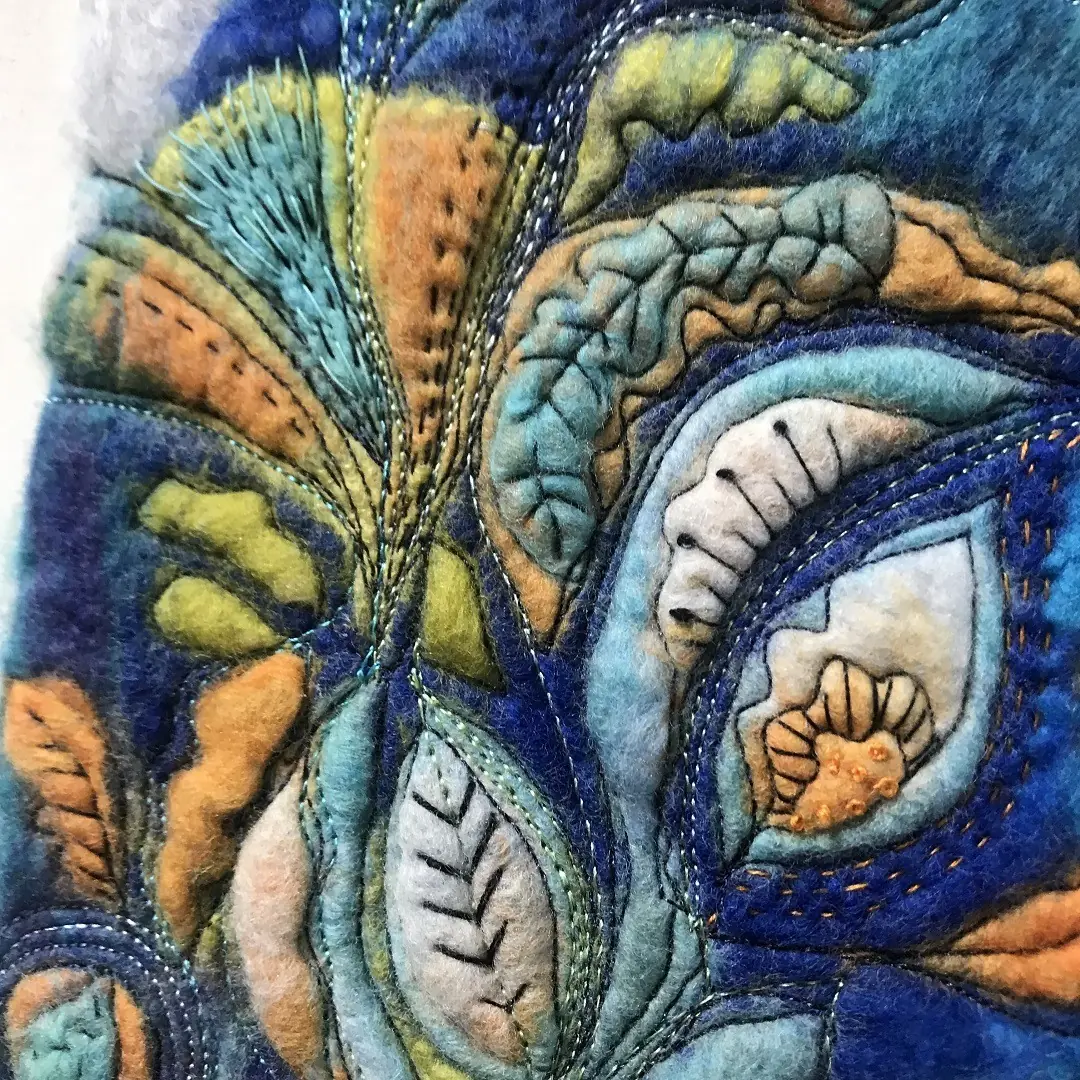
A spring garden
Primavera uses the colours of lime, rust and blue to form floral and leaf motifs, with both machine and hand stitch meandering between the shapes.
It was created after Jackie had received a request to make a larger than normal piece. She turned it down, but later wondered just how big a piece she could make.
After creating pre-felted motifs and positioning these onto a larger background with added wisps of wool, she felted them all together.
The piece left plenty of room for free motion stitching on her machine, using variegated, shiny, threads to emphasise and define certain shapes and areas.
“The most enjoyable part is finishing with hand embroidery.
I use very intuitive and informal mark making with thread, rather than classic embroidery stitches.”
Jackie Cardy, Textile artist
‘Most of my pieces feature abstract organic shapes, and Primavera is very much in the same vein, but this time these elements were more considered before being combined.’
‘Much of my work starts with an inkling of an idea which I then develop intuitively. Sometimes that’s dictated by the accidents of felt and the way the colours blend to give unexpected shapes and depth, which go on to inspire stitch.’
‘I made this in spring and called it Primavera. I like the vibrancy of the lime, rust and blue colours and the fizziness of the separate elements. It gives me the feeling of seeing a spring garden bursting out of the ground.’
In addition to wool roving and hand dyed velvet, Jackie sometimes adds dyed scrim, muslin and a variety of other fibres for texture.
In addition to her felt wall-hangings based on nature and landscapes, she has stitched some of her artwork onto backgrounds of silk paper, and made a range of brooches that include birds and sheep as well as more abstract shapes.
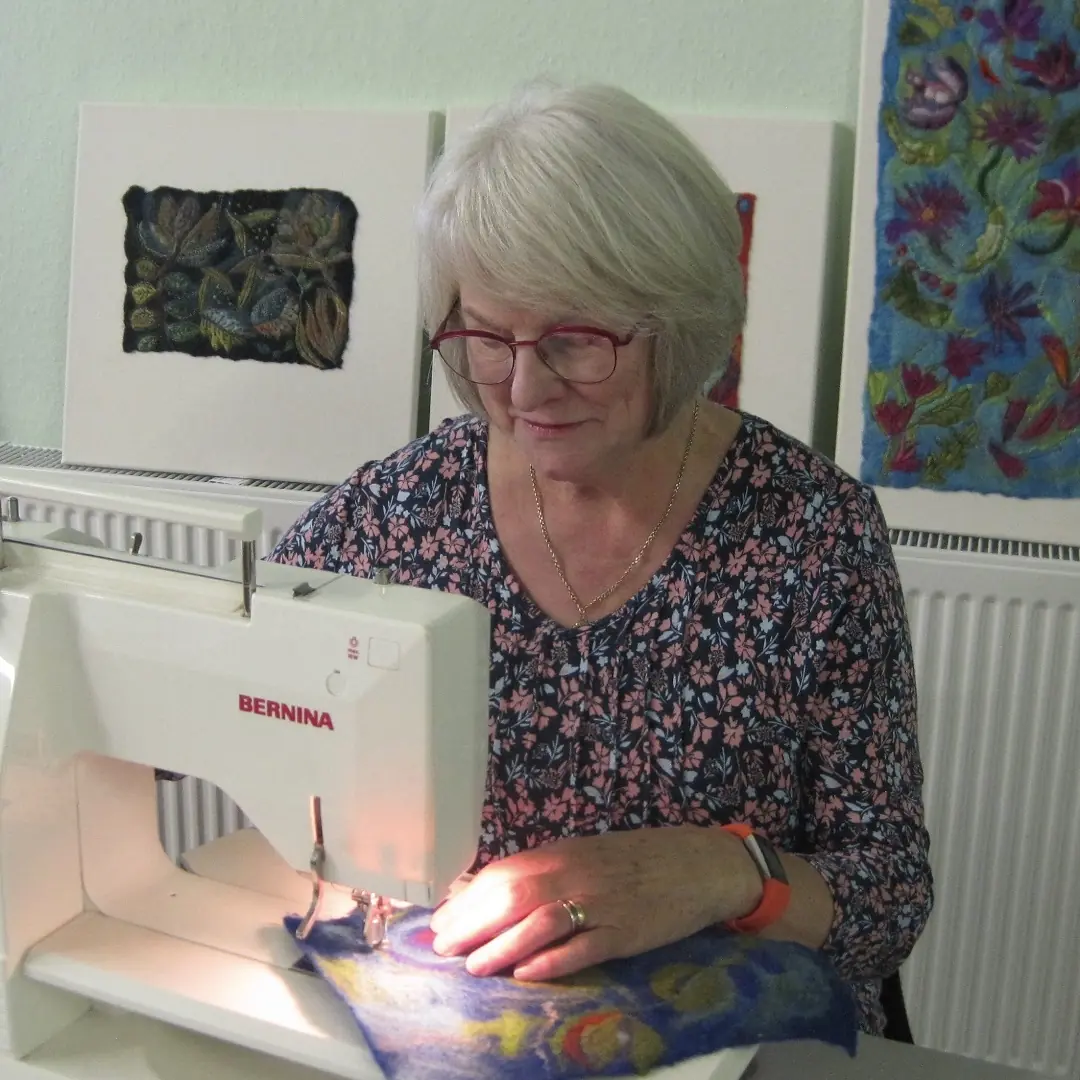
Jackie Cardy is based in a village in the West Pennine Moors, Lancashire.
After excelling in her City and Guilds in Embroidery in her 40s, she taught workshops and exhibited with various textile groups. She is a member of Fellside Felters in Chorley, Lancashire.
Website: jackiecardytextiles.com
Facebook: jackiecardytextiles
Instagram: @cardyjackie
Diana Nagorna
Diana Nagorna is a Ukrainian artist and textile designer specialising in the finest felt couture.
Her wearable art is exquisite, both in the finishing and fit of the felted base and in the beaded and textile adornments that lift it to a completely new level, though Diana has also made functional and comfortable clothes for everyday wear.
Using only natural wool, silk and fibres with wet felting, hot felting and nuno-felting techniques, her creations are recognised as sustainable fashion.
Since 2008, following her search for a material that would allow her to express her creative self fully, she has been making and selling her clothing, shoes, bags and accessories, as well as online tutorials on how to make them.
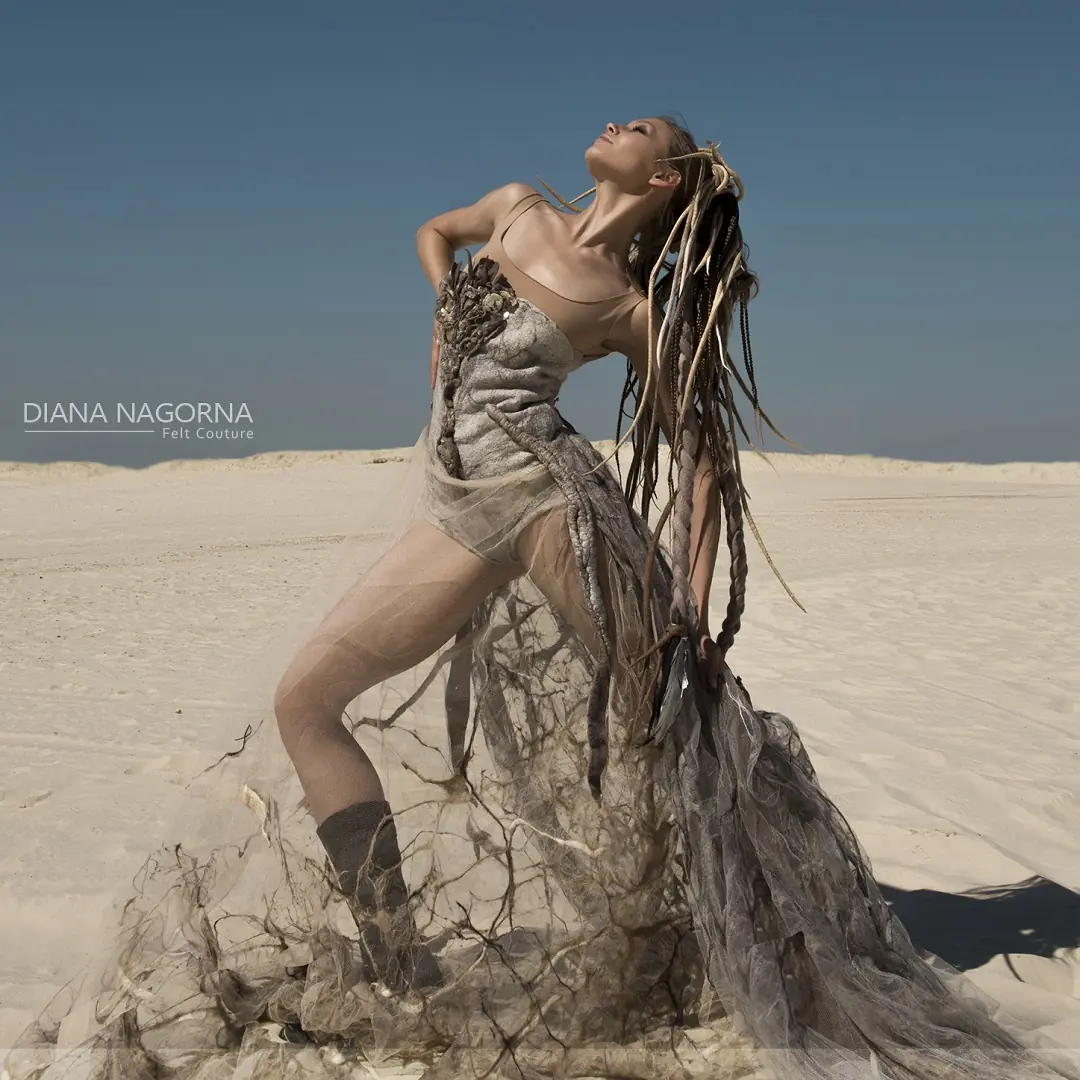
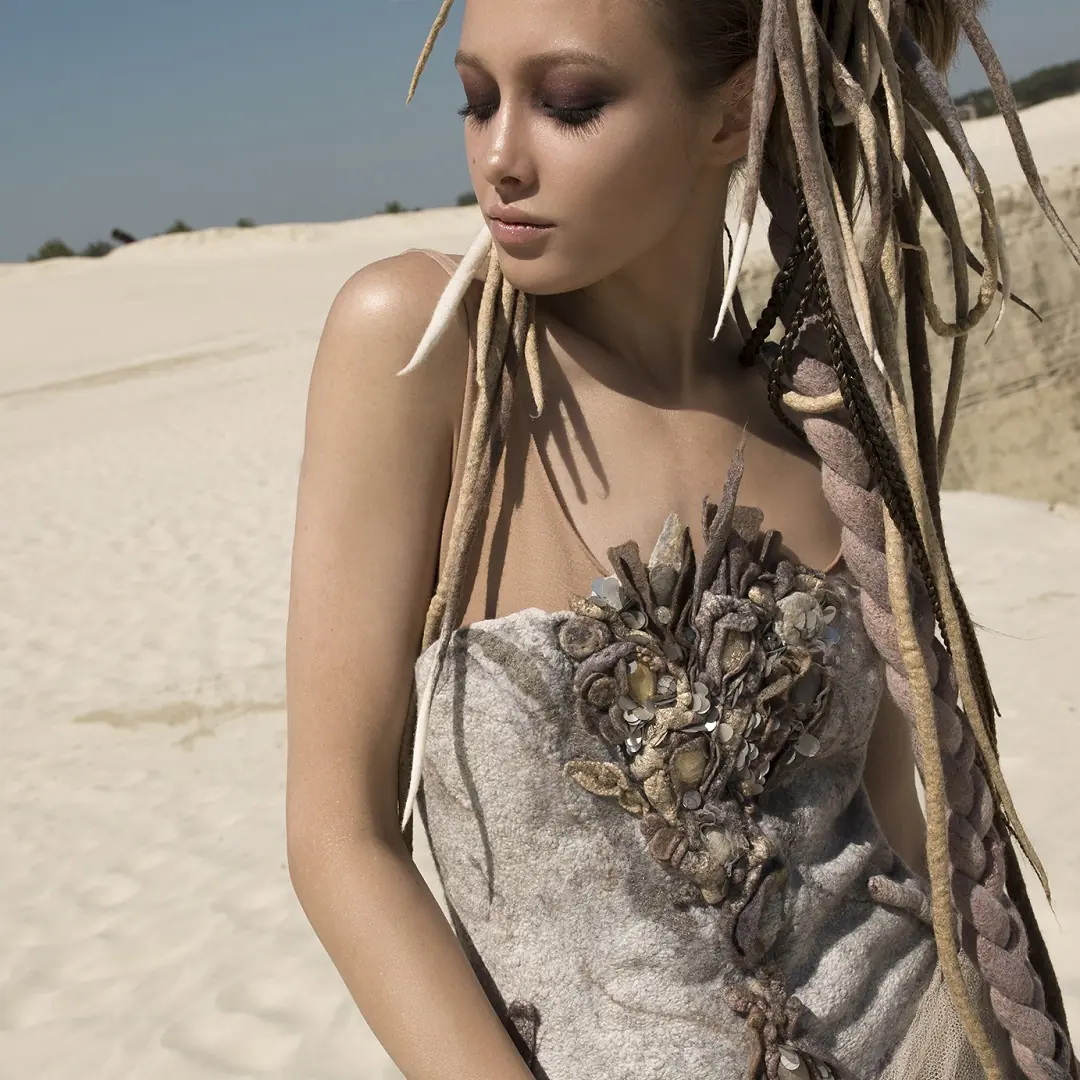
“I enjoy all stages of creativity from conception to implementation in the material.
It is a magical process.
In felting I can embody my most diverse creative ideas.”
Diana Nagorna, Textile artist
Felt’s many qualities
Dune Queen is a dress within Diana’s Felt Fluid collection, aimed at showing the multiple facets of felt: a warm material that is both lightweight and delicate yet offers sculptural properties. To create this particular costume Diana was inspired by images of the Burning Man festival. The costume was worn at the festival in 2022, something she had often dreamed of.
‘I like all stages of creation, especially when I’m not limited by any framework. This is pure creativity and improvisation.’
‘For an artist, this is priceless. My most favourite part of the work is the fantasy, volumetric embroidery in a free style.’
Diana plans to delve even deeper into felt as an art, and since 2021 she has been creating a variety of costumes in small thematic series as creative statements. Her dream is to make costumes for movies and shows.
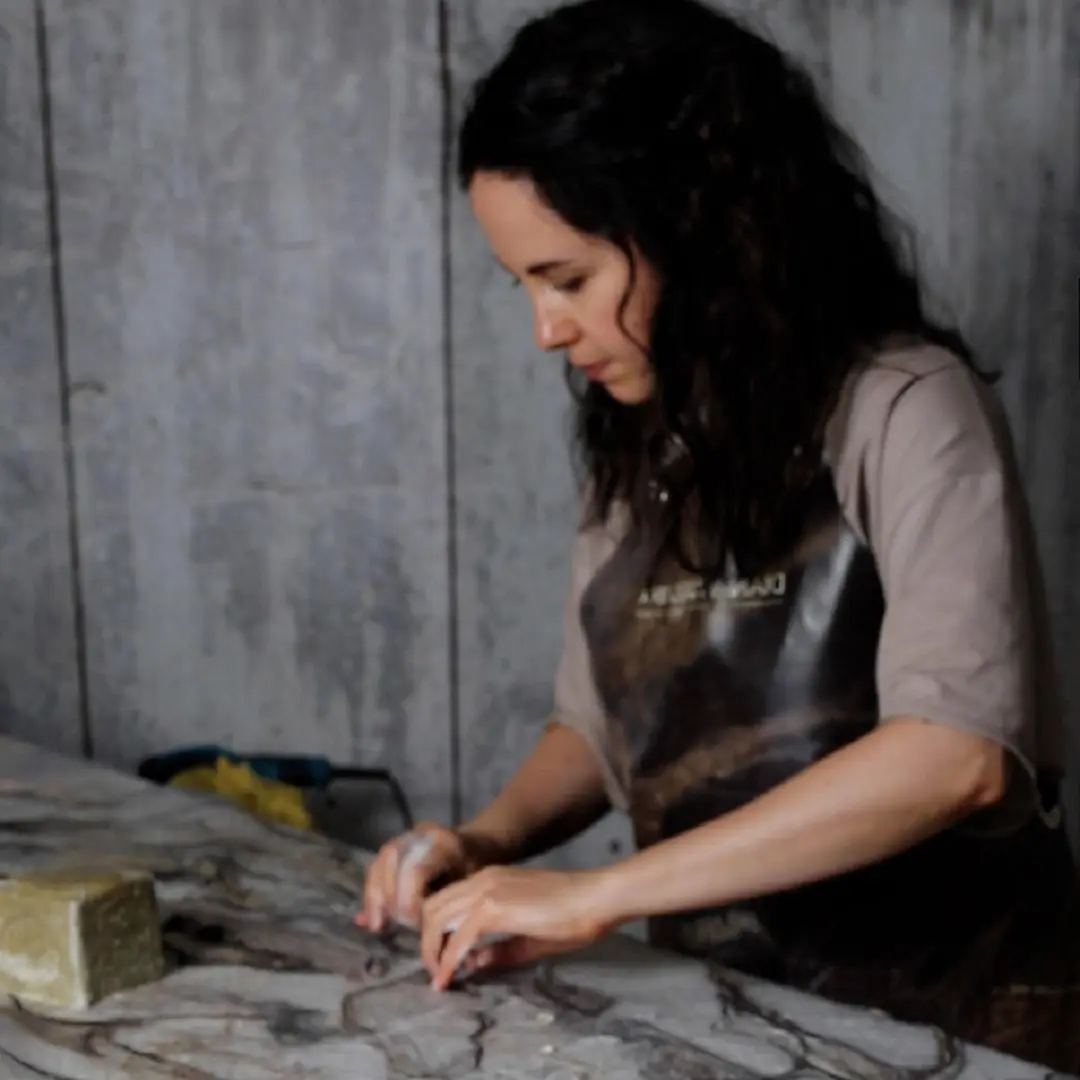
Diana Nagorna was born and raised in a small town in eastern Ukraine and now lives in Kharkiv with her family.
She studied at a children’s art school, then at Donetsk State Art College and graduated from the Kharkiv State Academy of Design and Arts. She works as an artist and textile designer and teaches online to students around the world.
Website: diananagorna.com
Facebook: nagornafelt
Instagram: @diananagorna_feltcouture
Moy Mackay
Moy Mackay‘s felt paintings are a pioneering development in the ancient craft of felting.
Upon completing her art studies and noticing the divide between what was regarded as fine art and what was not, Moy felt compelled to develop an art form that united both.
Taking advantage of the broad palette available in wool roving, and the array of exquisite complementary fibres such as silk and merino, Moy channelled her great passion and belief in what she was doing, to convince gallery owners to take her work.
Her felted paintings have helped to open up a whole new world in terms of texture and depth of colour, making headway for textile art to gain recognition in the art world.
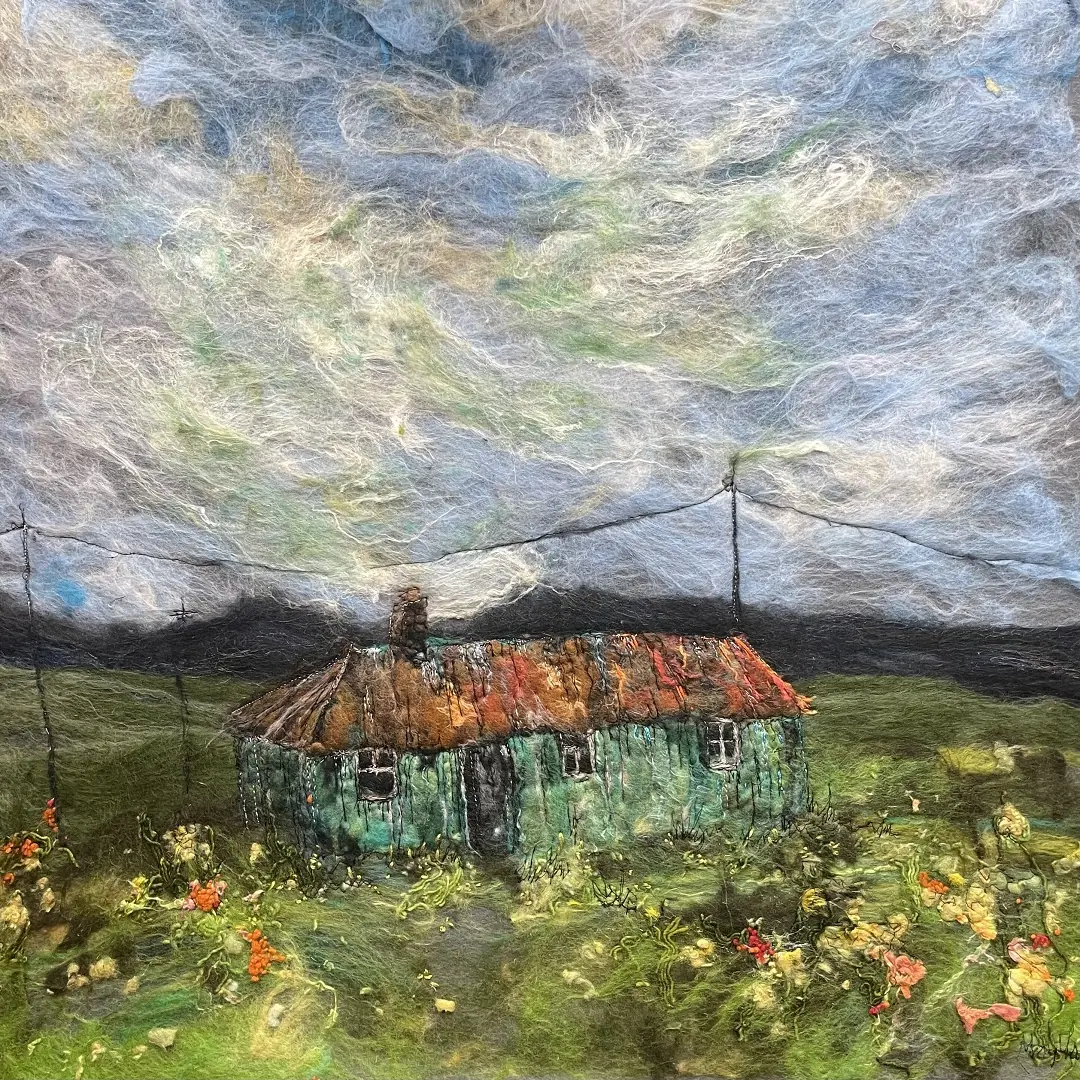
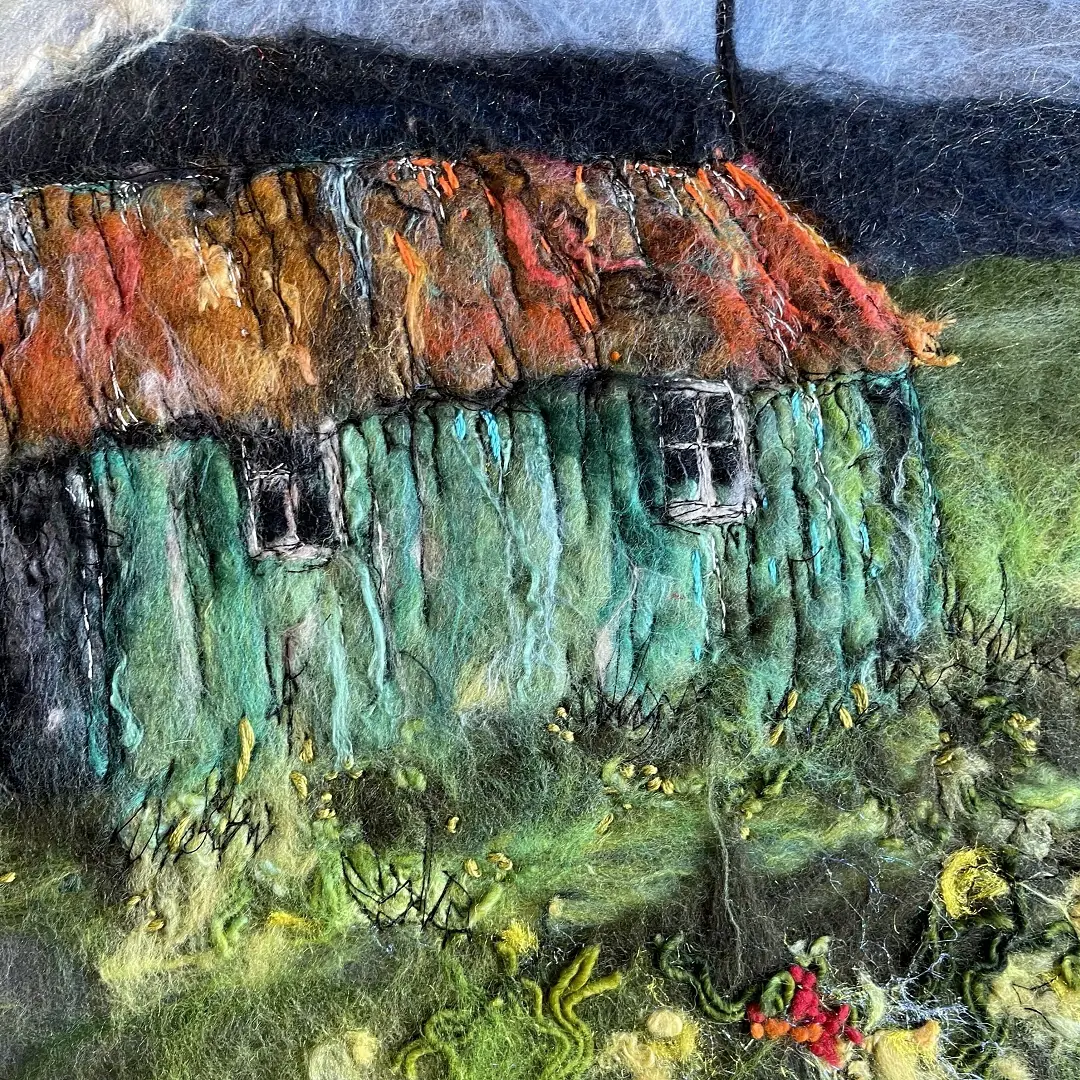
Crofts & bothies
Moy’s atmospheric piece The Green Hut was envisioned as she travelled to a remote cottage by the sea in the far north of Scotland to concentrate on her artwork. As she entered the majestic and rugged scenery of the Highlands, Moy began to feel inspired.
Fond of including landscapes and buildings in her work, her attention was drawn to the derelict old crofts and farm sheds along the way. She was so enthralled by one, a beautiful green tin hut, that, a few days later, Moy went back to sketch it and take photos.
“I was somehow enchanted by it.
Its colour, structure and placement within its surroundings.
I loved every aspect of it, I could visualise how it could be translated in fibre and stitch and was super excited to start.”
Moy Mackay, Textile artist
Moy was fascinated by the surfaces and patterns in the hut and saw an opportunity to explore new ways of expression in felt, adding marks and lines with free motion stitching.
As she worked on the piece, she used a variety of fibres alongside the merino wool to depict the vertical lines of the corrugated tin and the unusual placements of colour she noticed in the weathering of the metal.
The colour palette of green and rust was also a variation from her often favoured choices of blues and pinks.
‘Buildings feature strongly in my works at the moment. I am passionate about landscapes, but often an old croft or bothy will find its way in there.
Maybe I’m trying to convey a sanctuary within my work. A place that creates a feel good factor where the onlooker can create their own story within.
‘My purpose in making art is essentially to bring comfort and touch the senses in a positive way.’
‘Colour and art is a great therapy for our well being. If my creations can stir a positive emotion then my job is done.’
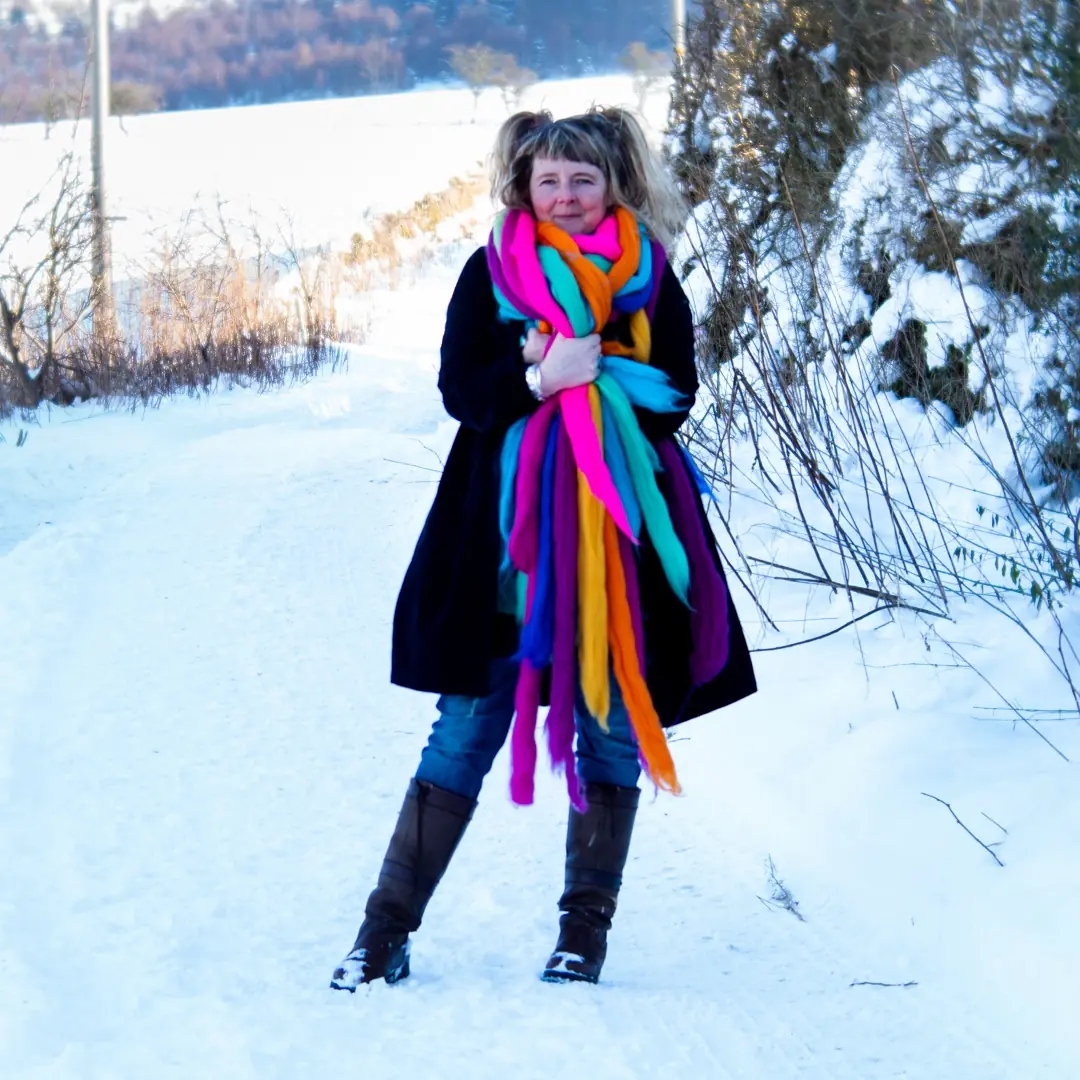
Moy Mackay graduated from Glasgow School of Art in 1990 and now lives In the beautiful Tweed Valley in the Scottish Borders.
She has published three books: Art in Felt and Stitch, Flowers in Felt and Stitch and The Art of Moy Mackay. In 2016 Moy was shortlisted in the Sky Arts ‘Landscape Artist of the Year’ and in 2013 gained a silver award in the textile category of the Craft & Design Selected Awards.
Website: www.moymackay.com
Facebook: Moy Mackay Artist
Instagram: @moymackay
Dagmar Binder
Dagmar Binder is fascinated by wool as a sculptural material. Following her art studies she experimented intensely with the medium and was so enthralled that in 1999 she left her teaching career to open her fibre art studio, Textillabor, in Berlin.
Dagmar is inspired by natural forms, often using these in her works in an abstract way.
“With felting I am mostly interested in seamless, three-dimensional creations.
This is the special potential of felt and can’t be done with other textiles in the same way.”
Dagmar Binder, Textile artist
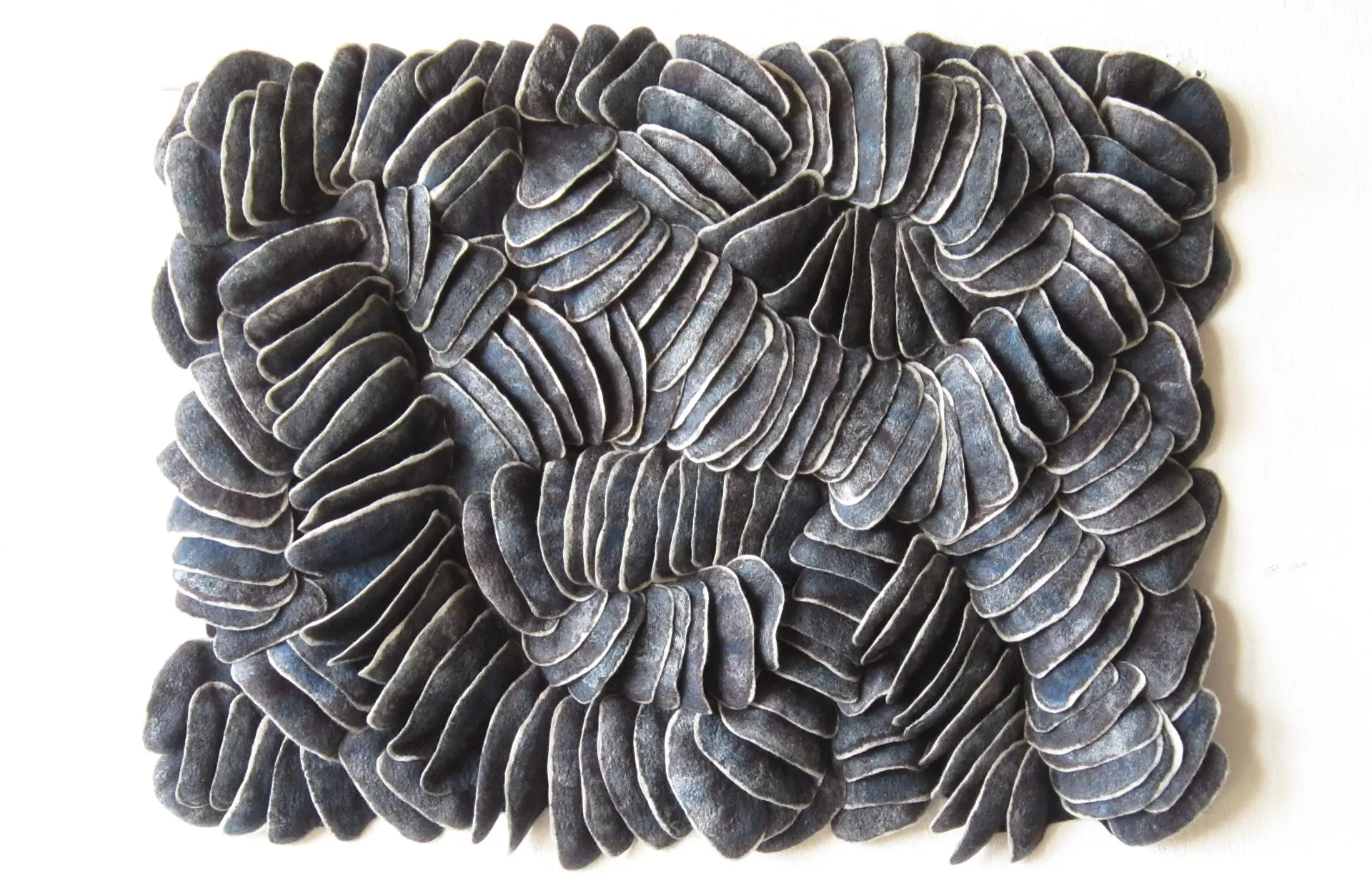
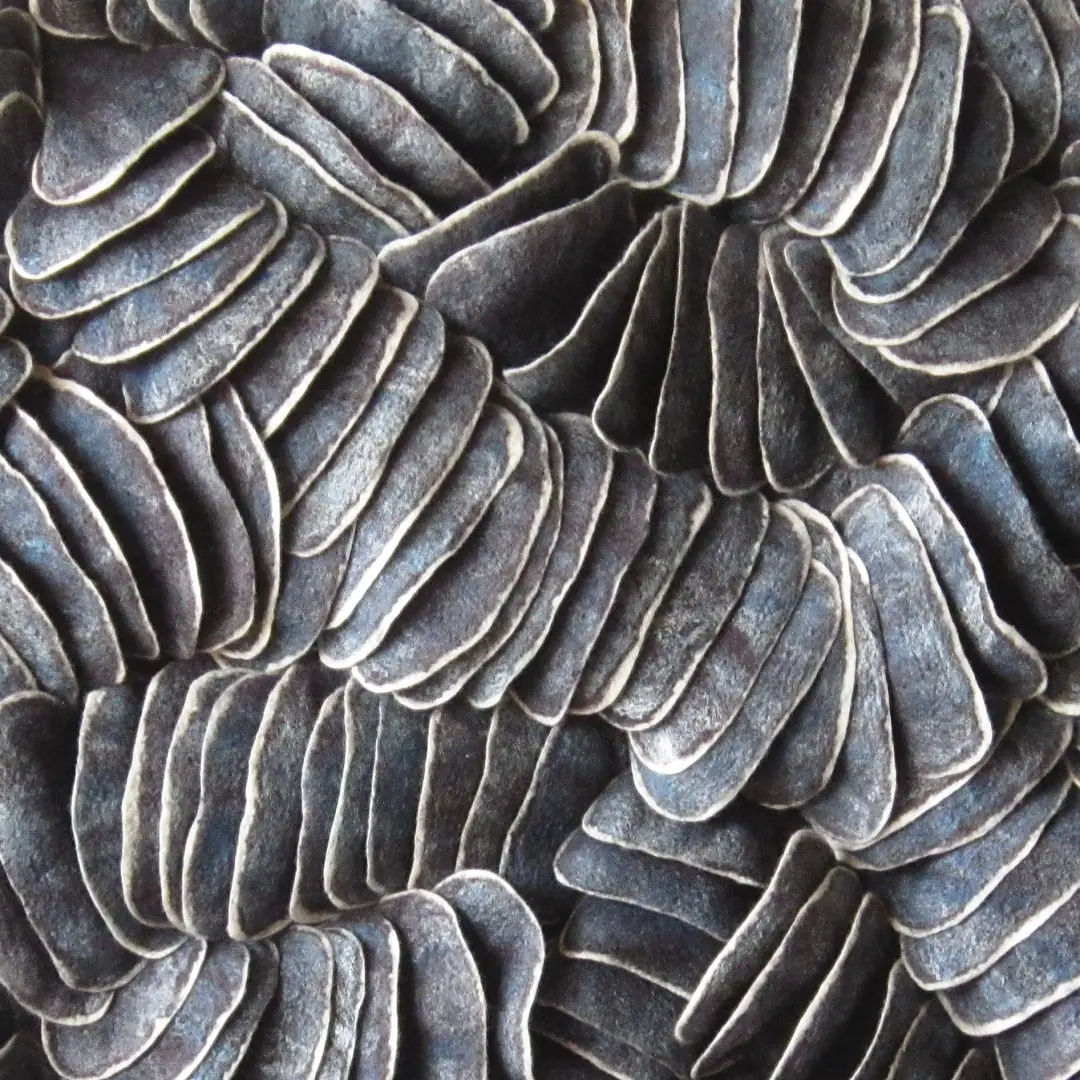
Lively & unconventional
In her artwork Gathering, she picked just one element and assembled many similar pieces into a new composition.
Gathering was conceived while Dagmar was considering the functional aspects of wearable artwork. She had been working on the scale-like shapes in a collar and selected this single element, playing and experimenting with its form.
While photographing the intermediate stages, she observed the dynamics of different versions, finally deciding upon one, and leaving others to serve as a starting point for future works.
The pre-felted scales took many weeks to make, their bases left unfelted so that they could be seamlessly joined to the base rug at the end.
As she worked intuitively, she decided on a dense structure, using resists to keep the raised parts separate from the base felt. After the wet felting process she unfolded the scales to give the three-dimensional view.
Dagmar saw that combining many scales together would create a dynamic linear pattern, and decided to let the scales, fins and lamellae reach out over the edge of the base rug, avoiding the use of a frame and letting the object grow into space.
‘The transformation of the fibres during the felting process is irreversible and not completely predictable.’
‘I closely observe the reactions of this lively and unconventional material and respond to unforeseen changes, either by removing or accepting, supporting and even underlining them as an individual feature of this work.’
‘In the very end, there will be a considerable change in expression when the so-far flat and wet felt is being shaped three-dimensionally and dried.’
‘Gathering catches the eye and leads us round and round in endless circles, with scales interlaced and running under and over each other, some at crosspoints.’
‘While one person might be reminded of a labyrinth or animal skin, it makes me think of a collective dance or celebration. I can hear voices singing together and feet stomping in a ritual.’
“I love to explore all kind of possibilities with this soft sculptural material, try out new techniques and push the boundaries of traditional feltmaking.”
Dagmar Binder, Textile artist
‘Felt as a soft, natural material seems very interesting to me for multiples or repetitive structures.’
‘Even starting from exactly the same shape and dimensions, each single reproduction would end up slightly different and in a subtle way express the individual within a family or crowd of same elements.’
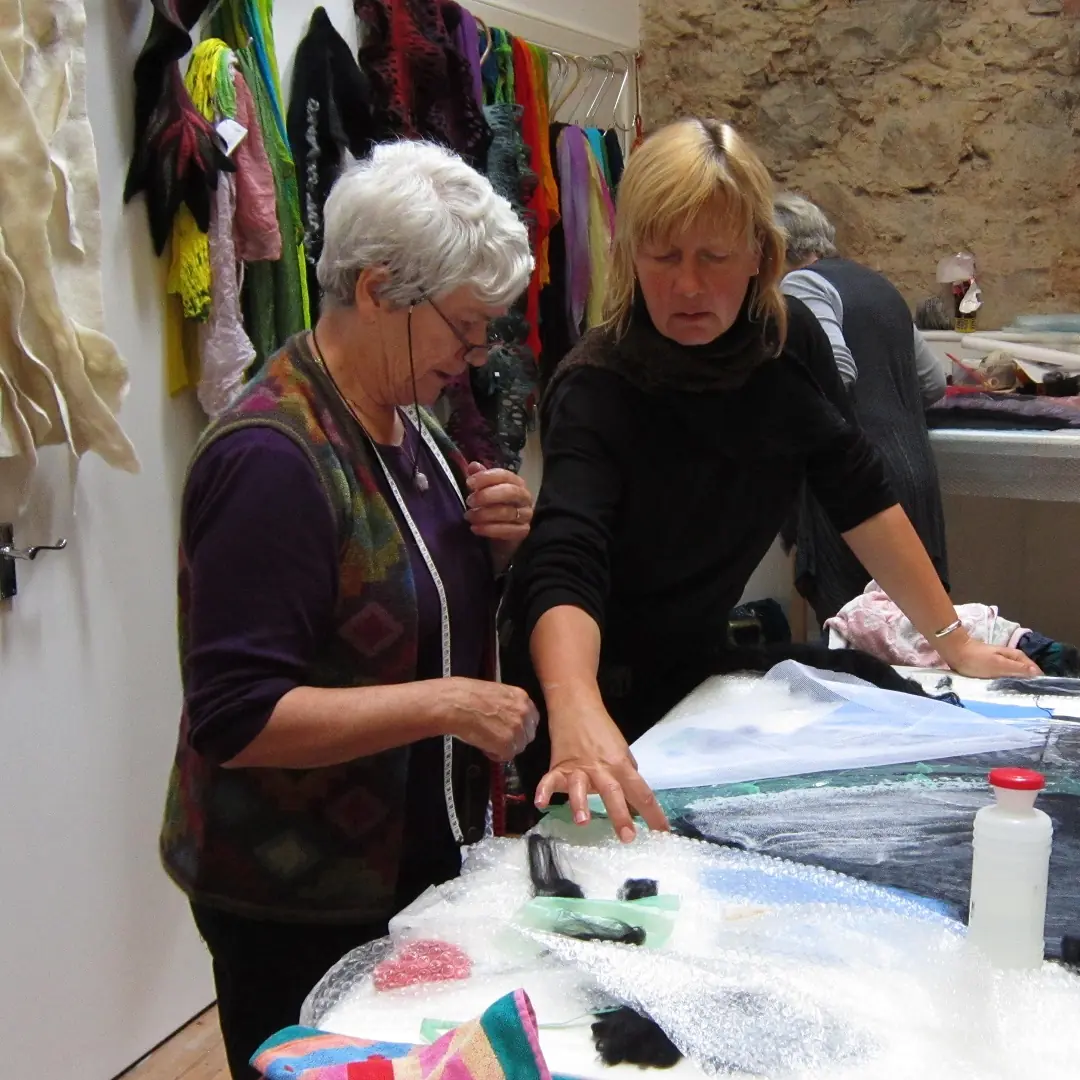
Dagmar Binder is a Berlin based felt artist and feltmaking tutor.
She studied at Berlin University of the Arts (1995) and has worked as artist in residence in Brazil, Peru and Bolivia. She teaches workshops in person and online, and has exhibited in numerous fibre art exhibitions and design fairs.
Her practice spans felt art objects, stage costumes and fashion accessories and recently she has focused on sculptural collars, scarves and wall hangings.
Website: www.textillabor.de
Instagram: @textillabor
Ksenia Shinkovskaya
Ksenia Shinkovskaya lives in Daugavpils in Latvia, between the powerful Daugava river and a beautiful lake, surrounded by forests, both of which provide inspiration for her felted artworks.
She started felting as a hobby in 2000, becoming a freelance artist a few years later. Sales of her small needle-felted creatures went smoothly until she experienced a difficult childbirth during which she briefly died. Her son grew to be happy and healthy but with delayed speech development.
Her natural concern was compounded by the fact that her contacts and markets were shrinking and her felting practice simply no longer flowed – no matter what she tried, it felt somehow forced. She defines this as the point at which her career as a designer ended and her life as an artist began.
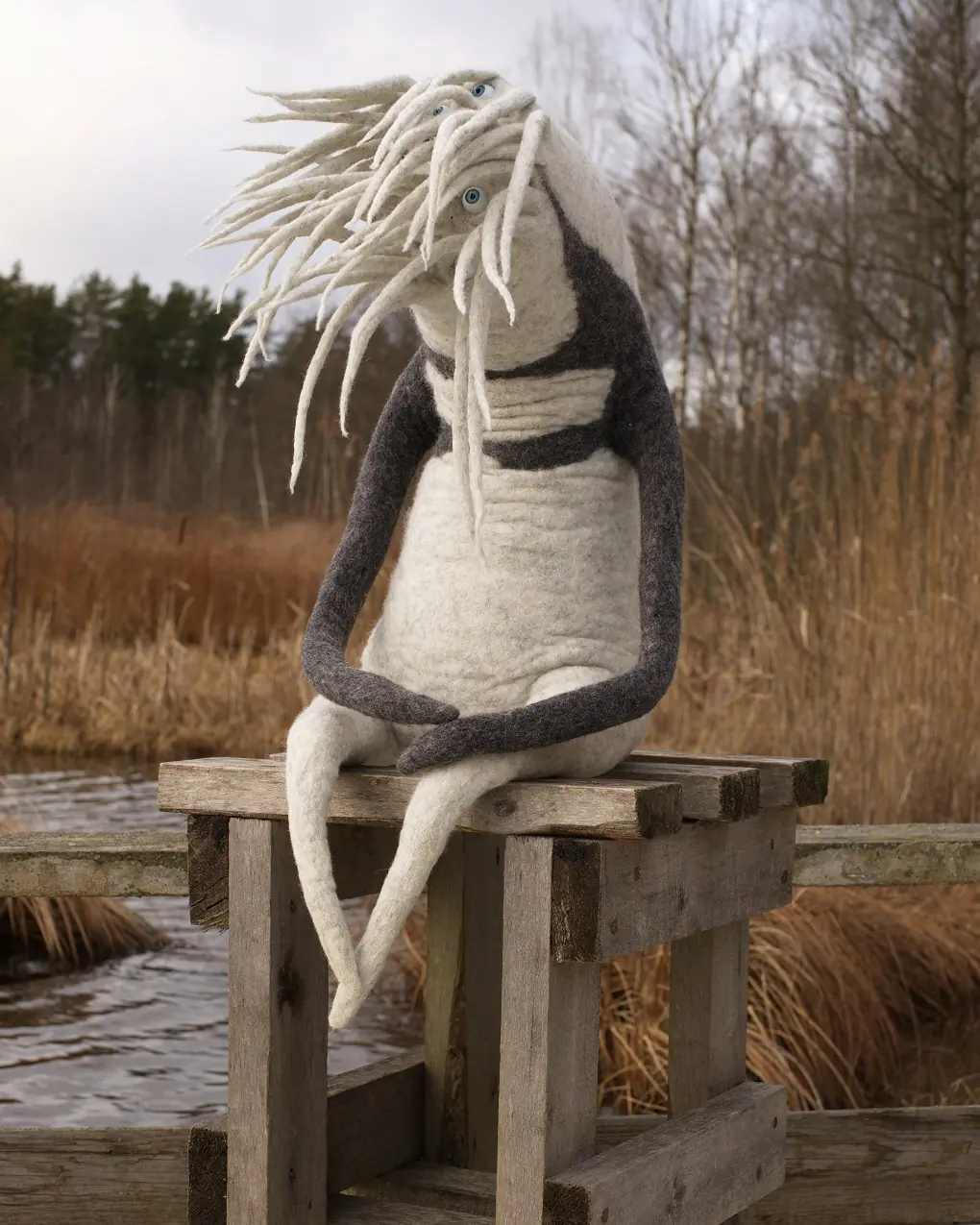
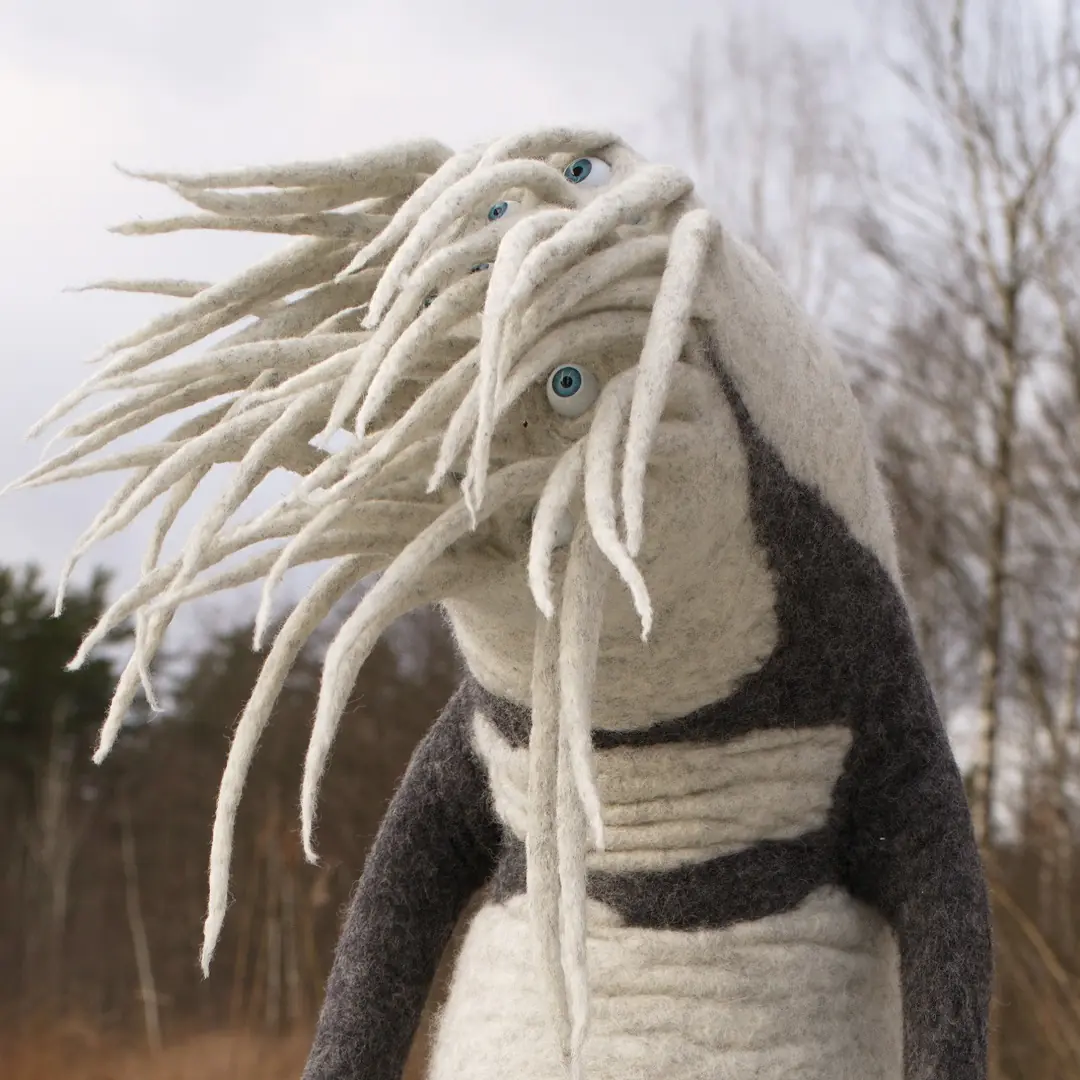
An inside job
All was not lost as from within came new inspiration to create a range of strange and magical figures with mirrors instead of faces – a range that became very popular with buyers and curators.
Since then many of her works, including Lakhudra, hint at what is contained within a person: the state of the soul, the psyche and the emotions. She expresses this in her felted sculptures without using human form.
The word lakhudra refers to the state of a woman’s hair when she has just woken up and it’s unbrushed. At the same time, it can reflect a dishevelled, unbalanced mental mood, when a person is worried but does not even know why.
“When I made this sculpture, I wanted to explore this unbalanced mood and embody it in physical form.”
Ksenia Shinkovskaya, Textile artist
Many of Ksenia’s dolls and sculptures are fitted with batteries that allow the eyes or interiors to glow. For her, it represents a metaphor for the victory of light over darkness.
She began making the eyes herself 20 years ago using her husband’s stained glass equipment, when the choice of ready-made factory eyes didn’t suit her desire for incredible, fantasy eyes. It has become a business with an enormous range, and now she is known as ‘the eye fairy’.
‘When my Lakhudra sculpture was ready, I decided to photograph it on the lake, where the fishermen stand. Imagine their surprise when I came in and sat Lakhudra on a chair.’
‘It was very funny! I made her with glowing eyes. In the dark you just see 20 burning eyes. It’s fascinating to sit next to her and feel her gaze.’
Ksenia’s range of felt artworks include dolls, brooches, sculptures, jewellery, postcards, sculptures and bags. Many of the dolls have mirror faces, cyclops-style faces or have multiple eyes.
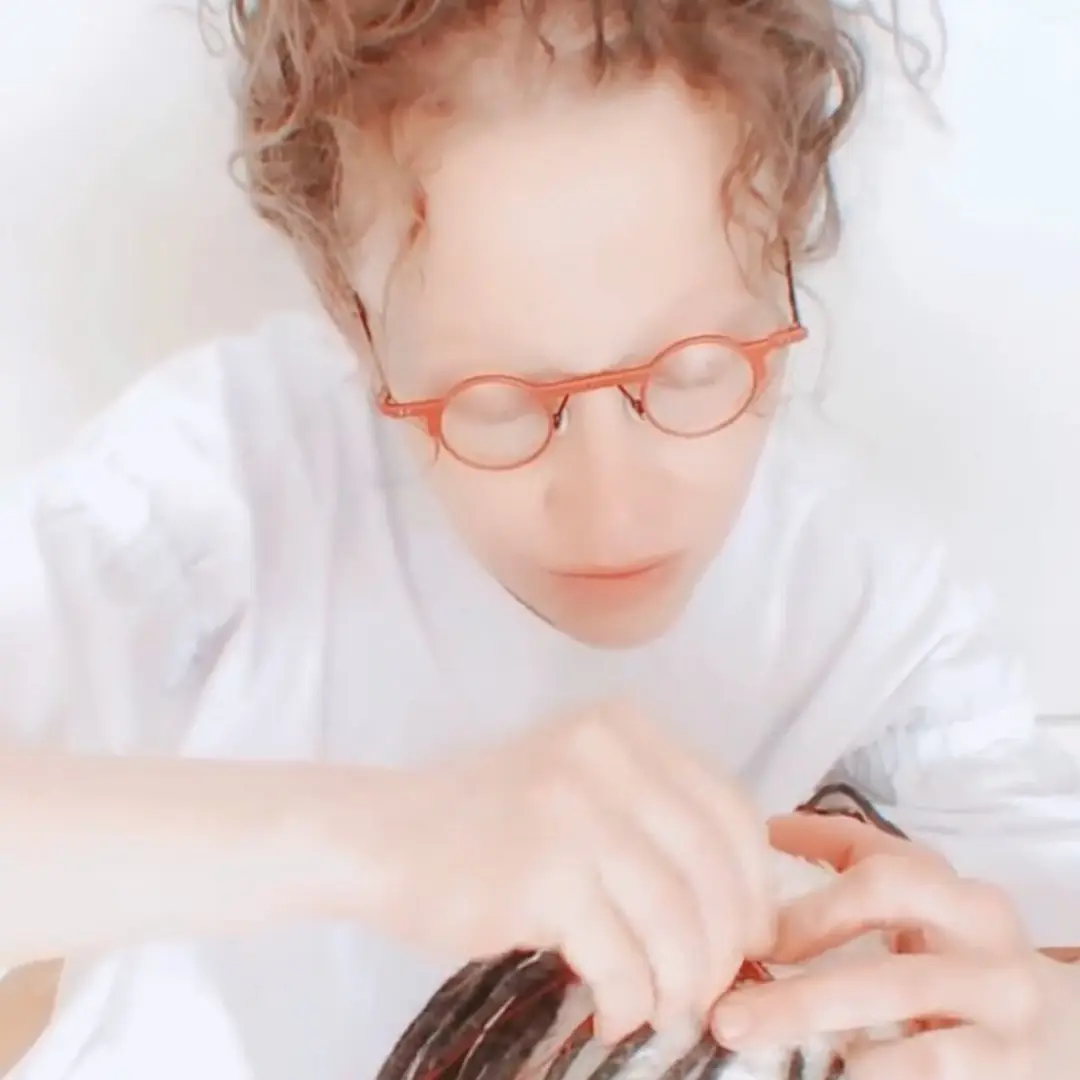
Ksenia Shinkovskaya lives in Daugavpils (Latvia).
She is a member of the Daugavpils Association of Artists and her sculptures have been exhibited all over the world.
In 2022 she participated in two biennials Material Thinking in China and the 10th International Biennale of Textile Art in Spain.
Website: wool-bulb.com
Instagram: @wool_bulb
Fiona Duthie
Fiona Duthie‘s felted work is bold in colour, contrast and form. An artist and maker for over 30 years, Fiona has focused on the intensive and dynamic use of surface design and textures in felt.
She has explored new material combinations including ceramics, paper and burnt wood, also making natural inks and using these in combination with wool fibres.
It is these she combined in her large scale installation Chromatic Navigation, which in 2022 was exhibited at Mahon Hall in her hometown of Salt Spring Island, British Columbia, Canada.
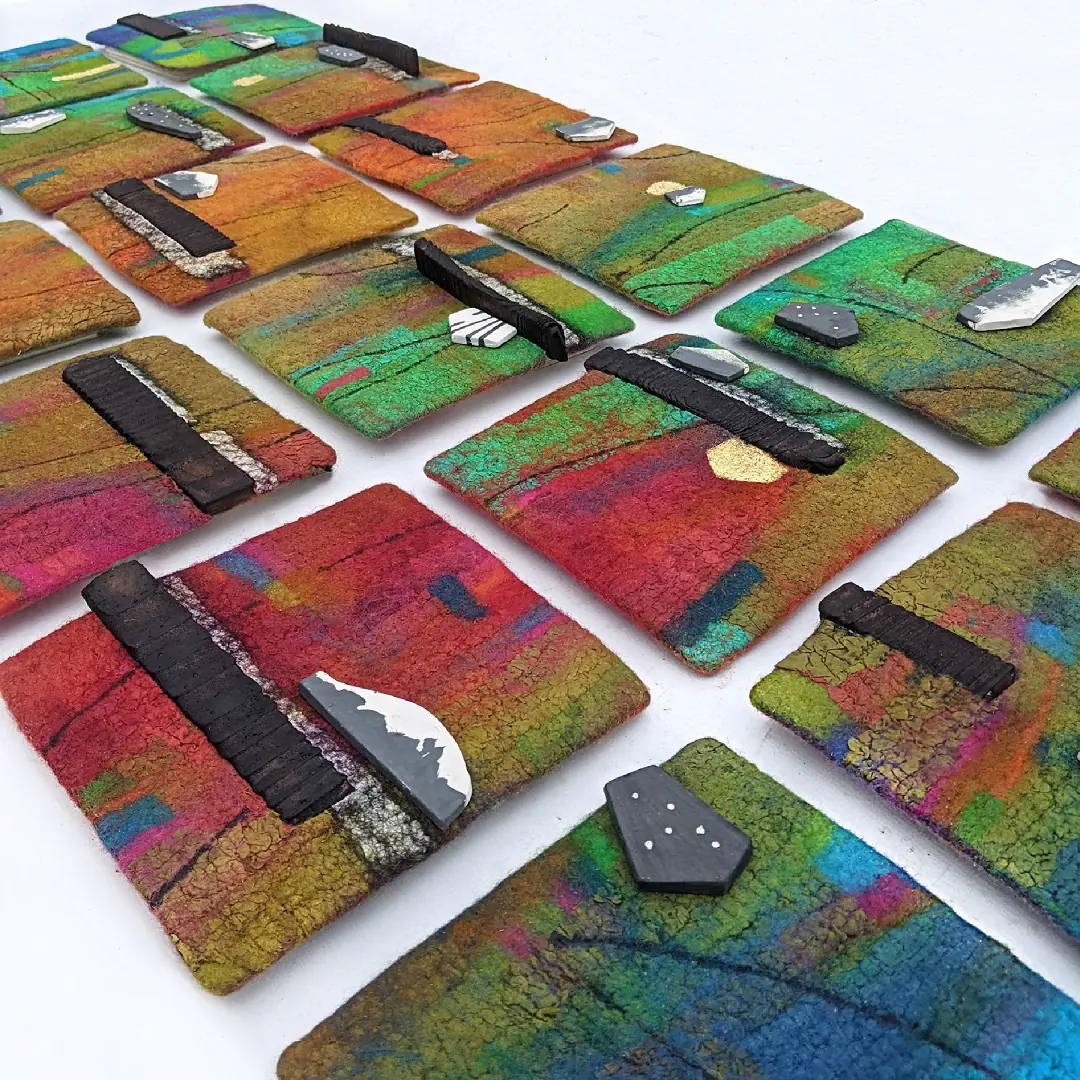
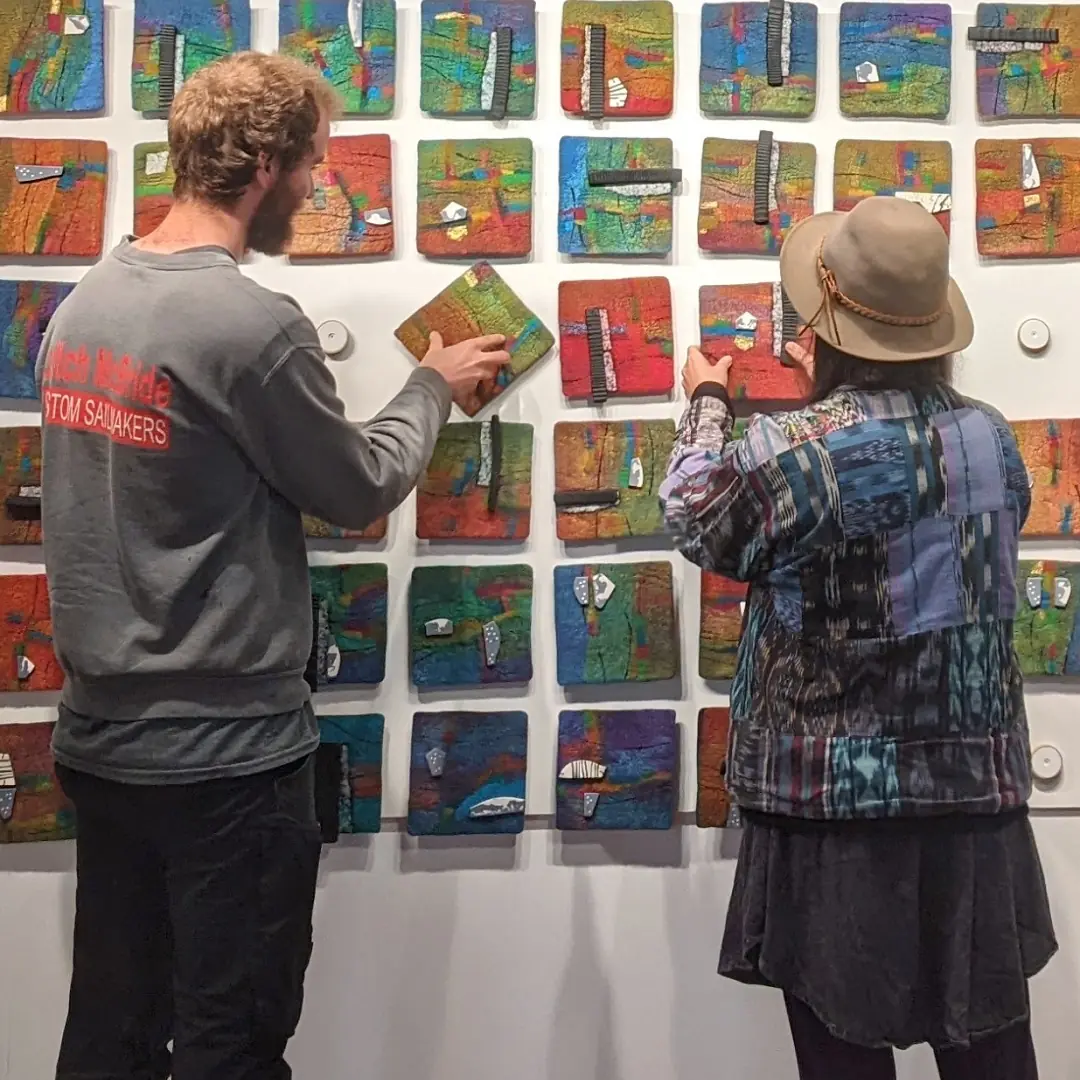
Challenging processes
The 200 felt wall tiles created a full spectrum of colour of over nine metres (29.5 feet) across the exhibition space. Fiona felt compelled to create the installation based on the global temperature map on 29 June 2021.
It was the day that an all-time high of 49.6 degrees Celsius was recorded in Lytton, BC, Canada, a town that the next day burned to the ground as a result of forest fire.
‘Chromatic Navigation explores individuality and community and how we each can influence thinking, circumstances and events through small changes and interactions.’
‘I’ve held a long fascination with weather maps – the beauty of the colours and constantly changing patterns.’
‘The forest fires and record setting temperatures of 2021 are reflected in these maps – the juxtaposition of beauty and destruction are so strong.’
“I wanted to create a large installation that could bring this contrast forward into people’s consciousness.”
Fiona Duthie, Textile artist
‘All of the materials I used are transformed through processes that challenge them – the physical agitation of wool fibres in feltmaking, the breaking down of the paper through wetting and manipulating in the felting process, the extreme temperatures involved in ceramic work and burning wood.’
‘Natural inks were made from the charred wood of the forest fire burnt trees themselves. Every material used becomes stronger, through these processes.’
‘Each material has its own language and personality. When working with wool, clay and wood, all together, they take on a hierarchy in the order of making. The clay ends up being the most hard with the least flexibility to form to the others.’
‘Wood is second, being able to be carved and shaped to mould to the clay, and then wool felt has the greatest flexibility. Even when firmly felted, it can be cut, shaped, sculpted and finished to meet the restrictions of the other two material forms.’
‘It takes time while making to understand these relationships, and also see how they can add to the messages in the artworks.’
‘As the viewers were encouraged to turn and switch the Chromatic Navigation tiles around to transform the overall pattern, and moved their bodies to physically engage with the pieces, it reminded me of why I’ve enjoyed creating wearable art collections.’
‘When the theme is right, a garment becomes a moving sculpture on a body, also changing how the wearer feels and moves depending on the design and structure of the piece.’
‘It was wonderful to watch people interact with the artwork and talk to them about the small changes they made to the piece as a metaphor for the small changes they could make in their lifestyles to lessen their carbon footprint and environmental impact.’
‘Chromatic Navigation explored a whole new, even larger scale of work for me, and a deeper connection formed between our environment and our actions, and between myself as an artist and my audience.’
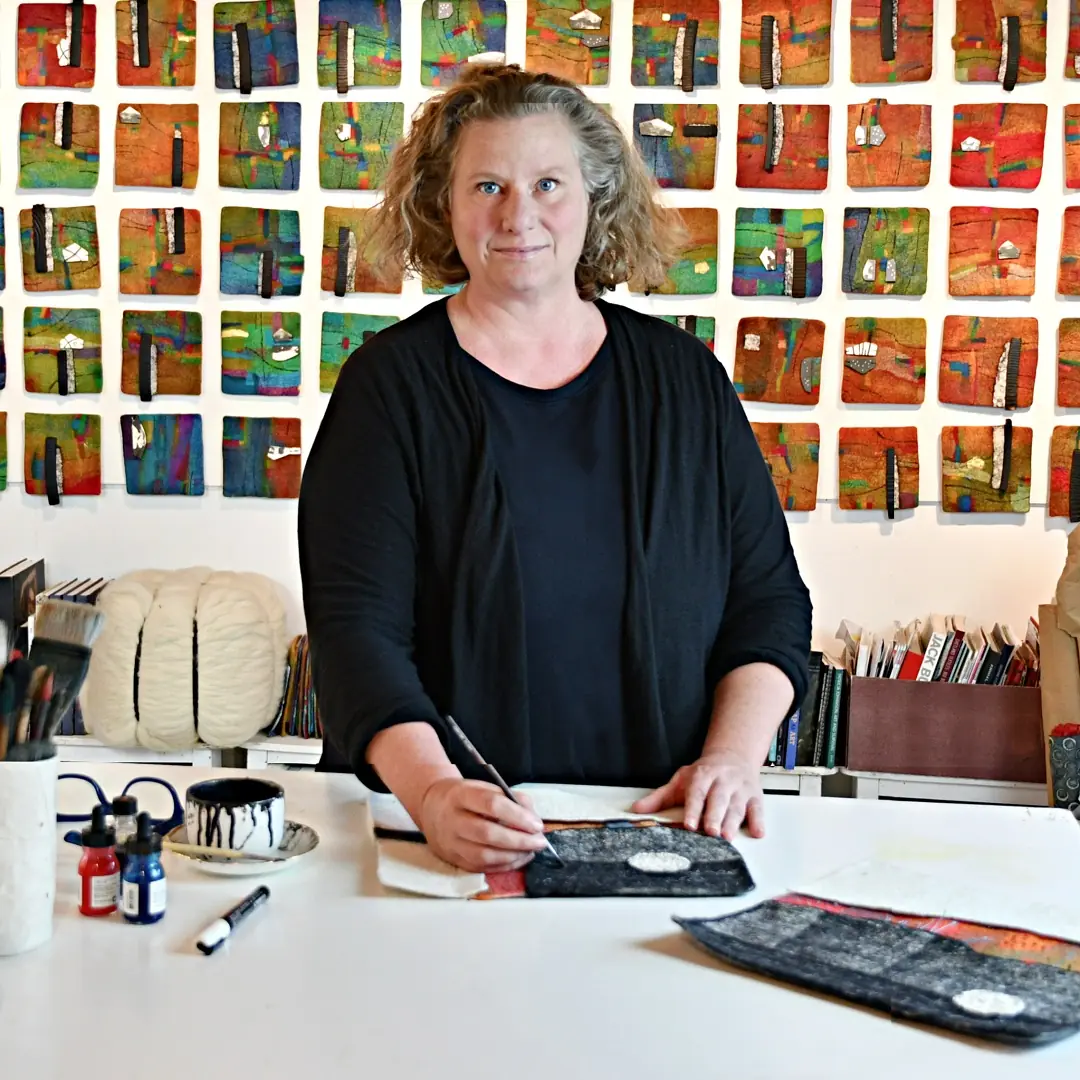
Fiona Duthie started her first business designing natural fibre clothing when she was 18 and has been a textile artist and tutor for over 30 years.
She is based on Salt Spring Island in British Columbia, Canada where she has a full time practice. She specialises in felt making and exhibits and teaches internationally.
Website: fionaduthie.com
Facebook: FionaDuthieFineFelt
Instagram: @fiona.duthie
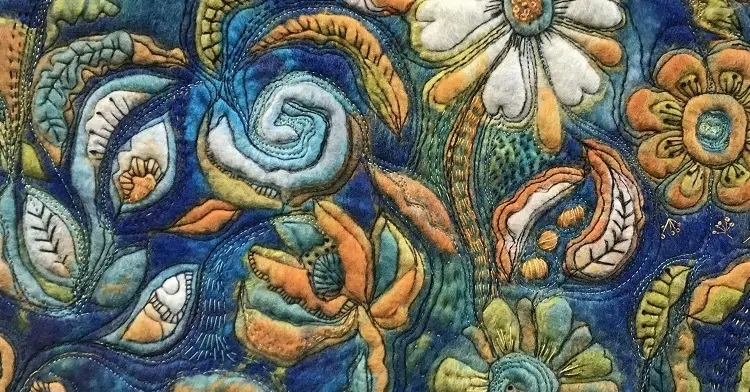
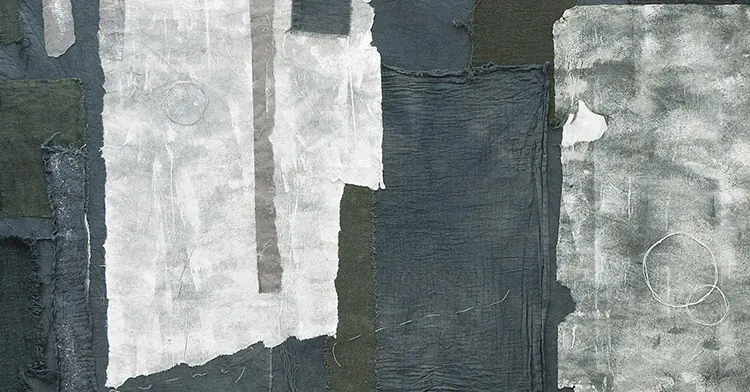
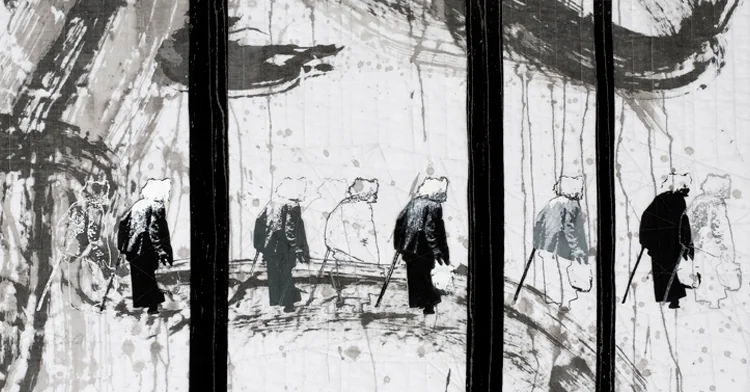
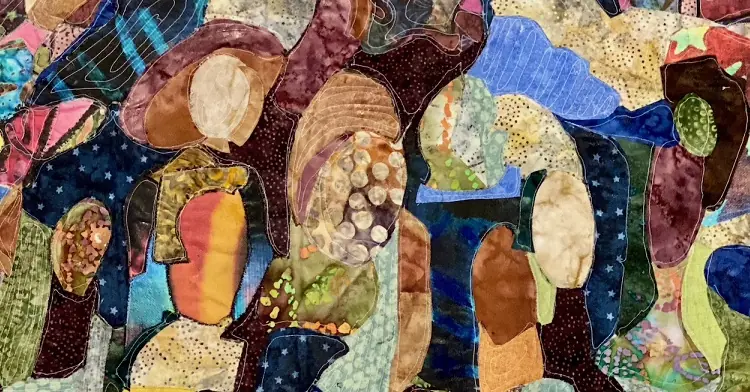
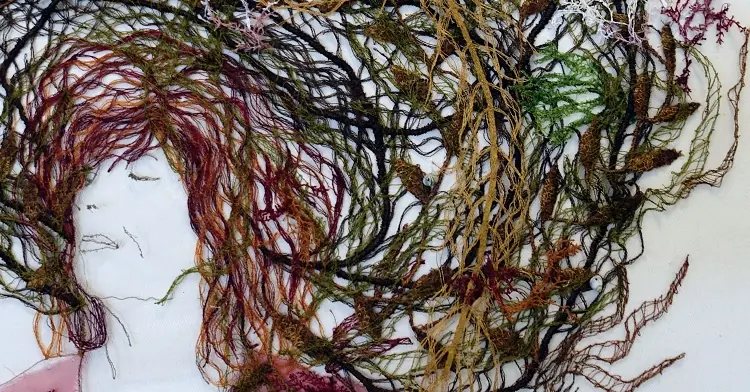

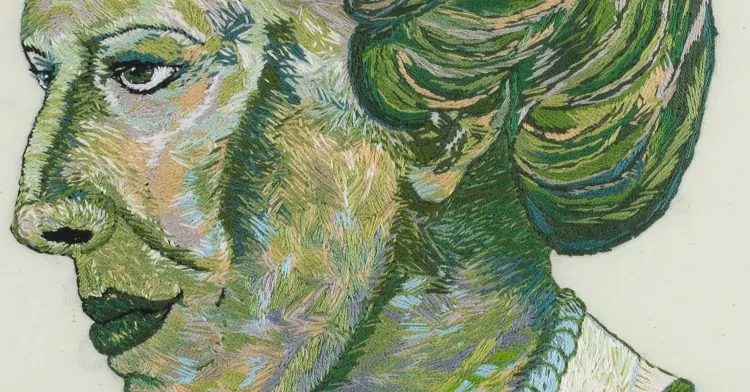
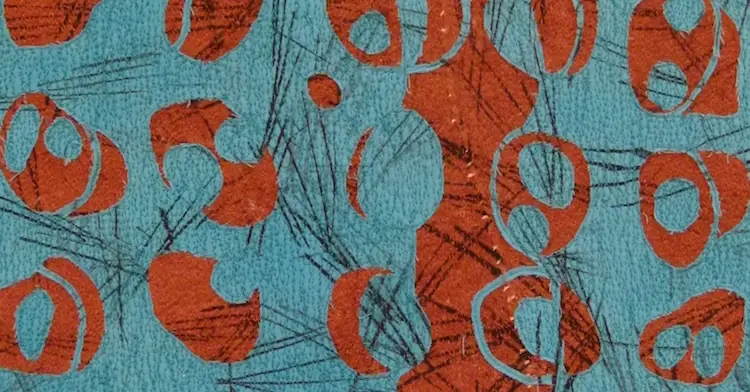
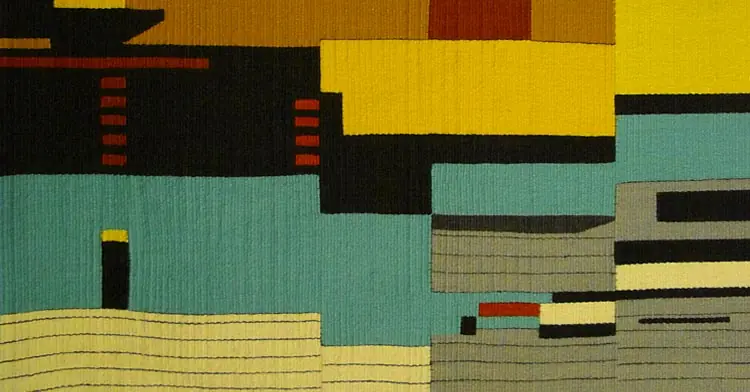
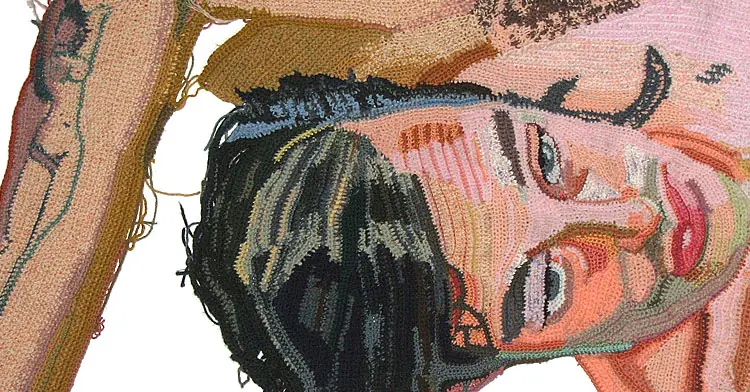
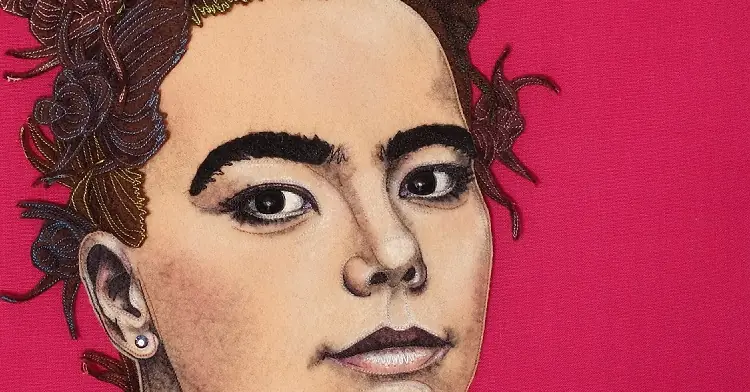
Comments